
Confectionery is the art of making confections, which are food items that are rich in sugar and carbohydrates. Exact definitions are difficult. In general, however, confectionery is divided into two broad and somewhat overlapping categories: bakers' confections and sugar confections. The occupation of confectioner encompasses the categories of cooking performed by both the French patissier and the confiseur.
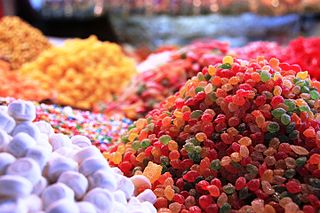
Candy, alternatively called sweets or lollies, is a confection that features sugar as a principal ingredient. The category, also called sugar confectionery, encompasses any sweet confection, including chocolate, chewing gum, and sugar candy. Vegetables, fruit, or nuts which have been glazed and coated with sugar are said to be candied.

Marshmallow is a confectionery made from sugar, water and gelatin whipped to a solid-but-soft consistency. It is used as a filling in baking or molded into shapes and coated with corn starch. This sugar confection is inspired by a medicinal confection made from Althaea officinalis, the marsh-mallow plant.

A chocolate bar is a confection containing chocolate, which may also contain layerings or mixtures that include nuts, fruit, caramel, nougat, and wafers. A flat, easily breakable, chocolate bar is also called a tablet. In some varieties of English and food labeling standards, the term chocolate bar is reserved for bars of solid chocolate, with candy bar used for products with additional ingredients.
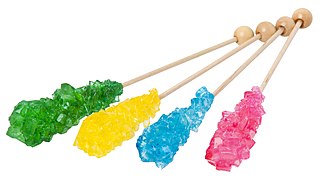
Rock candy or sugar candy, also called rock sugar, or crystal sugar, is a type of confection composed of relatively large sugar crystals. In some parts of the world, local variations are called Misri, nabat or navat.
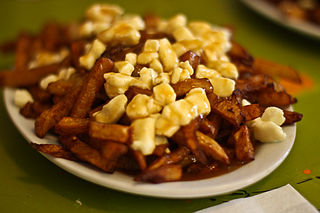
The cuisine of Québec is a national cuisine in the Canadian province of Québec. It is also cooked by Franco-Ontarians.

Jaggery is a traditional non-centrifugal cane sugar consumed in the Indian subcontinent, Southeast Asia, Central America, Pakistan, Brazil and Africa. It is a concentrated product of cane juice and often date or palm sap without separation of the molasses and crystals, and can vary from golden brown to dark brown in colour. It contains up to 50% sucrose, up to 20% invert sugars, and up to 20% moisture, with the remainder made up of other insoluble matter, such as wood ash, proteins, and bagasse fibres. Jaggery is very similar to muscovado, an important sweetener in Portuguese, British and French cuisine. The Kenyan Sukari ngutu/nguru has no fibre; it is dark and is made from sugarcane and also sometimes extracted from palm tree.

A macaroon is a small cake or cookie, originally made from ground almonds, egg whites, and sugar, and now often with coconut or other nuts. They may also include jam or chocolate or other flavorings.
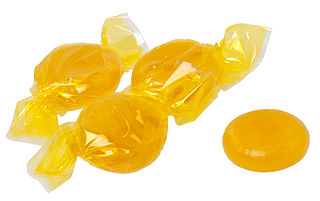
Butterscotch is a type of confectionery whose primary ingredients are brown sugar and butter. Some recipes include corn syrup, cream, vanilla, and salt. The earliest known recipes, in mid-19th century Yorkshire, used treacle (molasses) in place of, or in addition to, sugar.

Moret-sur-Loing is a former commune in the Seine-et-Marne department in the Île-de-France region in north-central France. It is situated on the river Loing, close to its confluence with the Seine. Moret–Veneux-les-Sablons station has rail connections to Montargis, Melun, Montereau-Fault-Yonne, Laroche-Migennes and Paris.
Penuche is a fudge-like candy made from brown sugar, butter, and milk, using no flavorings except for vanilla. Penuche often has a tannish color, and is lighter than regular fudge. It is formed by the caramelization of brown sugar; thus, its flavor is said to be reminiscent of caramel. Nuts, especially pecans, are often added to penuche for texture, frequently in the making of penuche candies. It is primarily a regional food, found in New England and some places in the Southern United States, though in the latter it goes by different names, including creamy praline fudge, and brown sugar fudge candy.

Maple taffy is a sugar candy made by boiling maple sap past the point where it would form maple syrup, but not so long that it becomes maple butter or maple sugar. It is part of traditional culture in Quebec, Eastern Ontario, New Brunswick and northern New England. In these regions, it is poured onto the snow, then lifted either with a small wooden stick, such as a popsicle stick, or a metal dinner fork.

Gofio is a sort of Canarian flour made from roasted grains or other starchy plants, some varieties containing a little added salt. Gofio has been an important ingredient in Canarian cooking for some time, and Canarian emigrants have spread its use to the Caribbean and the Western Sahara. There are various ways to use it, such as kneading, dissolving in soup, and baking. It can also be used as a thickener. It is also found in Argentina, Uruguay, and Chile, where it is known as harina tostada and is employed in a wide variety of recipes. The gofio commercially available in the Canary Islands is always finely ground, like ordinary flour, despite the definition given in the Spanish Dictionary of the Royal Academy.

A Konditorei is a business that typically offers a wide variety of pastries and typically also serves as a café. Konditoreien (plural) are found in many countries including but not limited to Germany, Austria, Switzerland, France, Denmark, Sweden, and the Czech Republic. In French-speaking countries, similar businesses are referred to as pâtisseries.
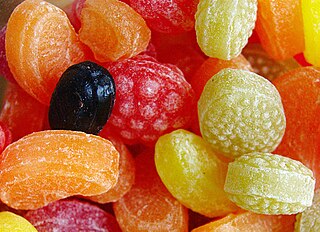
A hard candy, or boiled sweet, is a sugar candy prepared from one or more sugar-based syrups that is heated to a temperature of 160 °C (320 °F) to make candy. Among the many hard candy varieties are stick candy such as the candy cane, lollipops, rock, aniseed twists, and bêtises de Cambrai. "Boiled" is a misnomer, as sucrose melts fully at approximately 186 °C. Further heating breaks it into glucose and fructose molecules before it can vaporize.

Candy making or candymaking is the preparation and cookery of candies and sugar confections. Candy making includes the preparation of many various candies, such as hard candies, jelly beans, gumdrops, taffy, liquorice, cotton candy, chocolates and chocolate truffles, dragées, fudge, caramel candy, and toffee.

Shane Confectionery is an American candy shop and candy producer, located at 110 Market Street in Philadelphia, Pennsylvania. Currently owned by Ryan and Eric Berley, it is considered the longest-running confectionery business in the United States. The original confectionery business at the location opened in 1863. They are known for making traditional specialties including previous owner Edward Shane's buttercream chocolates and Pennsylvania clear toy candy.

Clear toy candy is a traditional confectionery that originated in Germany, England and Scotland. It is especially popular at Easter and Christmas. The hard candy is made in molds, in a multitude of fanciful shapes. The candy is tinted in bright colors, traditionally yellow, red and green. A stick is sometimes added before the candy completely cools to make a lollipop.





















